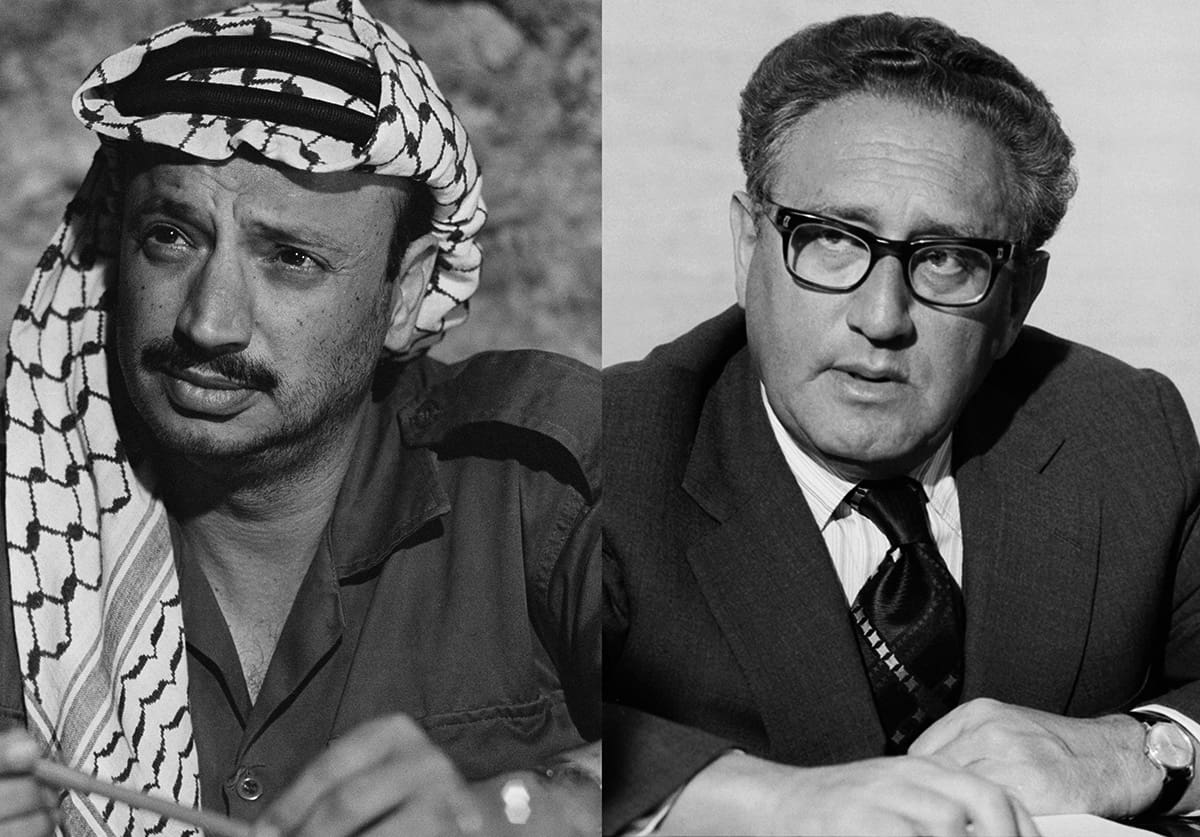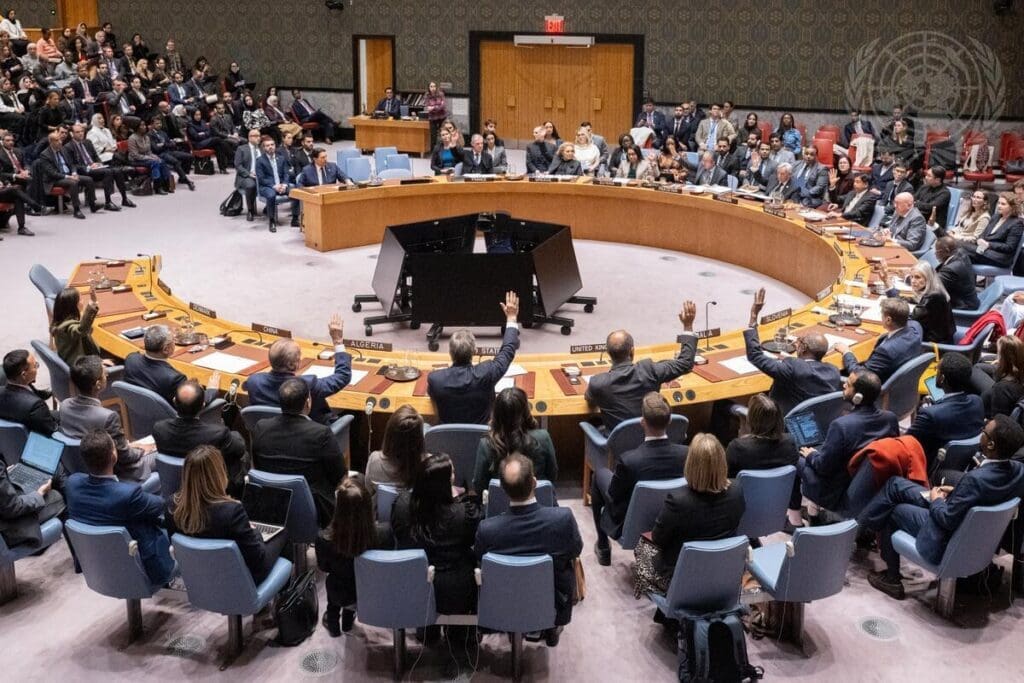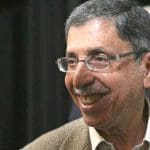
Overview
U.S. Secretary of State John Kerry’s highly publicized efforts to foster negotiations between Israel and the Palestinians coincides with the 20th anniversary of the Oslo Accords. The conventional wisdom is that the Palestine Liberation Organization (PLO) — weakened and on the verge of bankruptcy after the end of the Cold War and the first Gulf War — signed the Oslo Accords to stave off the emergence of an alternate leadership from the occupied Palestinian Territories and irrelevancy.
However, Al-Shabaka Policy Advisor Osamah Khalil draws on declassified U.S. diplomatic documents to argue that the roots of Oslo can be traced to the aftermath of the 1973 October War. He demonstrates that the PLO’s willingness to make considerable concessions occurred before entering negotiations or being recognized by the United States. Nor did these concessions occur when the organization was at its nadir, but rather after its most notable diplomatic achievements, securing United Nations and Arab League recognition as “the sole, legitimate representative of the Palestinian people.”
Khalil also shows that the PLO leadership, in particular key figures in Fatah, sought to establish a relationship with Washington at the expense of other Palestinian factions. These private conversations were in sharp contrast to the revolutionary rhetoric espoused by the PLO to appease its supporters, revealing a consistent pattern over four decades. In addition, while Israeli leaders often claimed there was “no partner for peace” during and after this period, the archival record reveals that the PLO leadership was eager for negotiations and confirms that American and Israeli intransigence delayed a resolution to the conflict.1
Revolution Until Victory?
The October 1973 War created an opportunity for Washington to resolve – or at least deescalate – the Arab-Israeli conflict. Since taking office in January 1969, President Richard Nixon and National Security Advisor Henry Kissinger focused largely on the Vietnam War. Meanwhile, Secretary of State William Rogers launched an effort to resolve the Arab-Israeli conflict based on UN Security Council Resolution (UNSCR) 242. The resolution called for Israel’s withdrawal from the territories occupied in the June 1967 War in exchange for peace with its Arab neighbors. Nixon and Kissinger actively undermined Rogers efforts, instead choosing to defer to Israel’s military strength and ignore overtures by Egyptian President Anwar Sadat.
Erupting in the middle of the Watergate scandal, the October War 1973 almost led to a superpower showdown. Overt American support for Israel also resulted in a six-month oil embargo by the Arab members of the Organization of Petroleum Exporting Countries. This combination of factors forced Kissinger – now holding the dual posts of Secretary of State and National Security Advisor – to engage in mediation efforts. With Nixon distracted by Watergate, Kissinger had unprecedented autonomy in foreign affairs and he worked toward convening a multi-lateral peace conference in Geneva with joint superpower participation. The looming question was whether the PLO would be invited to attend the conference.2
The PLO feared being left on the sidelines of any comprehensive agreement. In particular, the organization’s leadership was concerned that Jordan’s King Hussein would regain the West Bank. Like Sadat, PLO Chairman Yasir Arafat (Abu ‘Ammar) believed that the U.S. held the key to Israeli concessions and an eventual settlement. Arafat began to pursue relations with Washington publicly and privately.
William Buffum, U.S. Ambassador to Lebanon, reported a “sharp increase in signs that Fatah’s leadership is probing possibilities of direct contact” with American officials. These efforts coincided with “cautious attempts” by Arafat and his deputy, Salah Khalaf (Abu Iyad), to indicate their readiness to attend the Geneva Conference. At the same time, Buffum explained, the PLO leadership had to “allay fears among fedayeen rank-and-file” that the creation of a Palestinian state in the West Bank and Gaza would mean the “surrender or betrayal” of the organization’s long-term goals.3
One example was a November 27, 1973 speech by Khalaf at the Beirut Arab University. A “reliable source” informed Buffum that the overwhelming presence of opponents in the audience forced Abu Iyad to combine the “intransigent doctrinaire bombast typical of fedayeen ‘revolutionary’ jargon” with “elements of startling pragmatism.” The source reassured Buffum that privately Khalaf admitted he was committed to a peaceful settlement and “would not be averse to some sort of agreement” with King Hussein regardless of his public statements to the contrary. In spite of opposition from other groups within the PLO, in particular the Popular Front for the Liberation of Palestine (PFLP), Ambassador Buffum concluded that the leaders of Fatah and other PLO factions were “prepared to participate in peace talks and settle for [a] rump Palestinian entity.”4
One of the main factions to support Fatah in this effort was the leftist Democratic Front for the Liberation of Palestine (DFLP), a breakaway from and rival to the PFLP. Speaking at a December rally in Beirut, DFLP General Secretary Nayef Hawatmeh called for the establishment of an independent national entity on any land liberated from Israel. Buffum informed Kissinger that Hawatmeh’s speech was “remarkable.” He noted that it represented the “clearest public indication to date that [the] bulk of [the] fedayeen leadership is moving more and more out of its protective shell” in preparation for the peace conference.5
The Geneva Conference convened on December 21, 1973 without Syrian participation — nor was the PLO invited to attend. Although the initial meeting yielded no meaningful results, Arafat and Khalaf would continue to hint publicly in speeches and interviews at the PLO’s evolving position and willingness to attend future sessions.6 These indications were reinforced through back channels by prominent Palestinians authorized by Abu ‘Ammar to speak to American officials. Meanwhile, different PLO factions — including Fatah — continued operations against Israeli military and civilian targets, which often undermined the moderate image the leadership was attempting to project.7
The PLO’s overtures combined with the support of Arab leaders would lead some American diplomats and policymakers to advocate for official contacts with the organization over the next two years. Robert Houghton, charge d’affaires at the Beirut Embassy, attempted to explain the PLO’s different strands in a February 1974 cable to Kissinger. Arafat and Khalaf were considered “moderates,” he explained, because their views on an eventual settlement with Israel were “relatively more realistic and positive than those held by their die-hard associates and many of their followers.”8
“Even in the cloud cuckoo land of inter-fedayeen politics,” Houghton wrote, “it is possible to discern attitudes that are distinctly more reasonable (in terms of what some fedayeen leaders may eventually be willing to settle for) than others.” He reminded Kissinger that “on various past occasions [there were] concrete indications that most of Fatah’s top leadership would like somehow to associate themselves with [the] settlement effort if it holds out some promise of gaining wider recognition and respectability for fedayeen movement and future personal advantage of themselves.” In other words, the PLO’s leadership was willing to make a deal as long as their position and privileges could be ensured.9
Houghton further explained that the PLO’s goal of a democratic secular state did not mean that “they regard it as a practical possibility in either [the] short or long term.” Rather, it reflected an awareness that “fedayeen association with [the] settlement effort and establishment of [a] rump Palestinian state in West Bank/Gaza cannot be sold to Palestinian rank and file and Palestinian ‘masses’ who for past twenty-five years have nurtured myths of ‘return’ and ‘liberation’ unless they are presented in terms consistent with those unrealistic but deeply rooted aspirations.” Instead, the PLO’s leadership would present it as a “tactical maneuver” to prevent Jordanian control over the West Bank or as the initial stage to the eventual liberation of Palestine.10
It is important to note that these efforts by the Fatah leadership to indicate to Washington their willingness to compromise occurred before the PLO was recognized as the “sole, legitimate representative of the Palestinian people” by the UN and the Arab League. It was also before the 12th meeting of the Palestinian National Council (PNC), the PLO’s “parliament-in-exile,” where the organization signaled its willingness to accept the two-state solution.
The “National Authority” Program
The PNC met in Cairo on June 1, 1974. Fatah and the DFLP wanted to accommodate Moscow and Cairo with a more pragmatic approach, while demonstrating to Washington that it was a potential partner for peace talks. However, they faced resistance from the PFLP and its allies.
A compromise 10-point plan was agreed upon. It adopted the strategy of establishing a “national authority” on any liberated territory, but opposed the creation of any Palestinian “entity” which recognized Israel. To accommodate the rejectionists, the program still called for armed struggle and continued to reject UNSCR 242 because it did not recognize Palestinian national rights. In addition, if there was a major development requiring further consultation or a formal decision, the PLO’s Executive Committee was authorized to reconvene a special session of the PNC. Although the program did not specifically authorize the PLO’s leadership to attend a reconvened Geneva Conference, approval was obtained through a subsequent statement.11
In spite of the compromise, the PFLP continued to criticize the PLO’s new direction. It frequently accused Arafat of conducting secret negotiations with Washington and Amman and wanting to recognize Israel. Arafat tested the new program’s flexibility — and the PFLP’s patience — in September by signing a joint communiqué with Egypt and Syria signaling the PLO’s willingness to engage in negotiations with Israel. The PFLP responded by withdrawing from the PLO’s Executive Committee and Central Council. In addition, the PNC would not reconvene until 1977. These political tensions threatened to escalate into a military confrontation and permanent rift. Meanwhile, Arafat used the spirit of the 10-point program (if not the actual letter) to pursue relations with the United States.12
In Washington, the PLO’s new program appeared to confirm the assertions of those advocating for a relationship with the organization. National Security Council (NSC) staffer William Quandt argued that the program signaled qualified acceptance of a Palestinian state in the West Bank and Gaza. He lobbied Kissinger to establish an official channel of communications with the organization. Quandt argued that the dialogue would support a rapprochement between the PLO and Jordan and provide support to moderates within the organization. In spite of the PLO’s rhetoric, he asserted, “Arafat clearly wishes to work toward a political settlement” and recognize Israel’s right to exist. Although Quandt was not alone in this assessment, Kissinger and Israel were unwilling to respond.13
Egypt and Algeria also encouraged the U.S. to recognize (or at least talk) to the PLO. Arafat believed that UN and Arab League recognition would make it difficult for Washington to continue ignoring the organization. Although the PLO was awarded observer status at the UN, Washington’s policy did not change.
American officials, however, continued pressing Kissinger after Arafat’s November 1974 UN speech. Writing in early January 1975, Ambassador G. McMurtrie Godley asserted “however inconvenient its existence or repugnant its behavior, [the] PLO has become a reality” and has the sympathy and support of “at least a broad spectrum of Palestinian and Arab popular opinion across the region.” As the Arab states were unwilling to impose a solution on the Palestinians, the PLO was “the sole agency” capable of acting on their behalf in negotiations. Dialogue with the PLO, Godley argued, would help Washington determine the organization’s suitability as a negotiating partner and serve to support and encourage moderates within the organization. An overture – even one that was “informal and highly secret” — would benefit America’s relations with key Arab leaders, especially if it was rebuffed by the PLO. In spite of potential Israeli objections, he urged a reexamination of the issue. However, no change in U.S. policy was forthcoming and Arafat subsequently launched his own initiative.14
Arafat’s Offer
In May 1975, Republican Senator Howard Baker visited Beirut. Baker and staff from the Senate Foreign Relations Committee met with prominent Palestinian notables, including Georgetown Professor Hisham Sharabi and PLO officials Shafiq al-Hout and Nabil Sha‘ath, before a separate meeting with Arafat. The meetings occurred as Lebanon descended into civil war with the PLO allied with the leftist Lebanese National Movement (LNM).15
After discussing the continued tensions with Israel, Baker asked Arafat for the “basic requirement to fulfill Palestinian aspirations.” Referring to the PNC’s new program, Arafat replied that Palestinians had the right to establish a “Palestinian Authority on any territory that can be liberated.” Baker pressed the PLO Chairman as to what he would “settle for?” “Whatever Israel can be gotten to give up,” Arafat responded, “even Gaza.”16
Although his goal was to establish a democratic state for Arabs and Jews, Arafat reassured Baker that “this is not the dream for next year.” “If the Israelis withdraw from all the territories occupied in 1967, or less than that,” Arafat stated, “the Palestinians would be prepared to establish their authority on the liberated land.”17
Baker informed Kissinger that in spite of his public persona, Arafat was not “strident in tone or belligerent.” Instead, he had the “mildness and geniality” of “a skilled politician.” He noted the contrast to the prominent Palestinians the Congressional delegation met with who spoke with “uncompromising stridency.” Baker explained that Arafat’s “tone and personality suggested an awareness of the limits of practical possibility. I had the feeling he would have conceded more if the ‘rejectionists’ were not looking over his shoulder, or if he had more to show for his comparative moderation.”18
The meeting with Baker occurred two months after Arafat met Democratic Senator (and former Presidential Candidate) George S. McGovern. Arafat reassured McGovern that the PLO would recognize Israel and form a Palestinian state comprised of the West Bank and Gaza. McGovern later announced these details in a press conference and the PLO did not issue a denial.19
In spite of Arafat’s attempts to appear moderate, Kissinger was unmoved. He continued working toward a second disengagement agreement between Israel and Egypt, while ignoring Syria and the PLO. The Sinai II agreement was signed in September and was accompanied by a secret memorandum of understanding (MOU) between the U.S. and Israel, in which Washington agreed not to “recognize or negotiate with” the PLO as long as it did not recognize Israel’s right to exist or accept UNSCR 242 and 338.
Undeterred, Arafat made a proposal in late February 1976 through the office of UN Secretary General Kurt Waldheim, which called for Israel to withdraw from the West Bank and Gaza. A combined UN and Arab League peacekeeping force would be deployed for a six month period to administer a trusteeship over the territories. After which, it would be turned over to the PLO. Arafat believed this would help break the deadlock with Israel over mutual recognition. Although he doubted Israel would accept the proposal, Brian Urquhart, Under Secretary General for Special Political Affairs, speculated that Arafat was signaling to Washington that “despite its public statements, [the PLO] was willing to accept Israel’s right to exist and a limited West Bank/Gaza state.”20
To ensure that the proposal was relayed to the Ford administration, Arafat also discussed it with Democratic Senator Adlai Stevenson III who met him in Beirut. The proposal relayed to Stevenson offered even more concessions. Israel only needed to withdraw from “a few kilometers” in the West Bank and Gaza. Arafat explained that it would “give him something he could show his people before he could acknowledge Israel’s right to exist.” Stevenson, however, was skeptical that the proposal would be acceptable to Syria in spite of Arafat’s assurances to the contrary.21
Arafat’s proposal was leaked to the Washington Post, where Stevenson recounted his discussion with Abu ‘Ammar. Stevenson was hesitant to call it a “hard proposal,” instead describing it as “an offer.” He added that Arafat “wanted this to get around.” Proposal or not, it was rejected by Israel.22
WAFA, the Palestinian news agency, issued an immediate denial of the story. “There is no truth whatsoever to statements mentioned by [the] paper,” declared an anonymous PLO official, “We are surprised, and we condemn this intentional distortion of talks which took place between Arafat and Stevenson.”23
In spite of the PLO’s denial, the Washington Post published an editorial entitled “PLO Trial Balloon.” It encouraged the Ford administration to investigate Arafat’s proposal further. “The pressures on Mr. Arafat to move into the political arena are real and continuing,” the editorial stated. “How strong these pressures are depends not just on Palestinian dynamics but on the attitudes of others. They should be encouraged, not ignored or dismissed at every turn.”24
By the end of the week, Faruq al-Qaddumi, Head of the PLO’s Political Department, reiterated the denials. At a press conference in Stockholm, Qaddumi dismissed the reports as “lies and falsifications.” A solution would only be reached, he declared, “by escalating the armed struggle.”25
Syria’s intervention into the Lebanese Civil War as well as the U.S. Presidential elections ensured that Arafat’s proposal would be ignored in the short term. Kissinger was pleasantly surprised that Assad was threatening to invade Lebanon in order to prevent a PLO-LNM victory. Assad feared that Syria would be “squeezed” between “radical” regimes in Lebanon and Iraq. He also hoped to dominate the PLO through the Syrian-backed faction, Sa‘iqa, and replace Arafat. Although Kissinger wanted the PLO weakened, Israel also threatened to invade Lebanon if Syria intervened. The Ford administration feared an Israeli invasion would lead to a larger regional war and another oil embargo in an election year. Israel, however, did not follow through on its threat. Instead, Washington actively supported Israeli efforts to supply the Christian Phalange militia with weapons and ensure a stalemate.26
A second issue was that the combined Syrian-Sa‘iqa forces had weakened — but not decisively defeated — the PLO. As Kissinger explained at a June 18 cabinet meeting, “it looks now like no one will gain an overwhelming victory.” He believed this “moderate outcome” would benefit peace efforts.27
PLO-U.S. Security Cooperation
Arafat’s offer was not the only secret attempt to develop relations with the U.S. during this period. From 1973 to 1979, ‘Ali Hassan Salama (Abu Hassan) shared intelligence with the Central Intelligence Agency’s (CIA) Robert Ames. The head of Force 17 – Arafat’s personal bodyguard unit – Salama was acting on orders from Abu ‘Ammar. As an intelligence channel, this relationship was not considered subject to Kissinger’s MOU with Israel.28
The Salama-Ames relationship grew out of Arafat’s attempts to engage with the United States. In November 1973, Kissinger dispatched General Vernon Walters, deputy director of the CIA, to Morocco to meet with a top PLO official. Kissinger later wrote that Walters had instructions only to listen and obtain “as clear a view of Palestinian thinking as possible” – not to make proposals. Walters was also to reiterate America’s commitment to King Hussein’s regime and stress that it would “oppose any threat to the survival of Israel and any challenge to its legitimacy.” In addition, Washington threatened to actively oppose the PLO if it was responsible for further attacks on Americans. Kissinger stated there was only one additional meeting in March 1974. Although no formal relationship was established, he claimed that meeting the PLO prevented “radical assaults on the early peace process” and ended attacks on Americans by Fatah. “Otherwise the meeting yielded no lasting results,” Kissinger wrote. However, this claim was only partially true.29
Salama and Ames met at New York’s Waldorf Astoria Hotel during Arafat’s November 1974 UN visit. The goal was to come to an agreement: If the PLO (or at least Fatah) would stop attacking American officials, Washington would recognize “the legitimate rights of the Palestinians.” This was less than the PLO hoped for. Nevertheless, the intelligence sharing agreement continued even after Salama’s death and apparently only ended after Israel’s 1982 invasion of Lebanon.30
Yet even before the agreement with Ames, Salama was providing the U.S. with information determined to be of mutual benefit. In a meeting with Embassy officials to plan for Arafat’s UN visit, Salama informed them that a foiled plot to assassinate King Hussein at the 1974 Arab League Summit may have been organized by Abu Iyad and backed by Libyan leader Muammar el-Qaddafi. Qaddafi, he said, “corrupts every one of us he touches.” Abu Hassan also reassured Embassy officials that the PFLP would not be conducting any operations in New York or elsewhere in order not to tarnish the PLO during Arafat’s UN appearance.31
The escalation of the Lebanese Civil War provided the PLO with an opportunity to further demonstrate its value to Washington. Although Kissinger was bound by the MOU with Israel, as he explained to President Ford there was “no commitment to Israel not to talk to the PLO exclusively about the situation in Lebanon.”32 Fatah provided protection to the U.S. Embassy and private residences of American officials. In mid-June, escalating fighting and the assassination of the new U.S. Ambassador to Lebanon, Francis Meloy, led to the decision to abandon the Embassy. Salama reportedly oversaw the evacuation.33
During a White House Press conference, reporters questioned President Ford about the PLO’s role in the evacuation. In response, Ford noted the PLO’s cooperation in evacuating Americans and others “without any incident whatsoever.”34 Two days later, the New York Times reported that WAFA had quoted a letter of thanks from Kissinger to the “Palestinian leadership” and also printed the PLO’s response.35
There would be no immediate benefit to the PLO from assisting with the Embassy evacuation. Although President Ford’s envoy to Lebanon, Talcott Seeyle, advocated for the creation of a Palestinian state in the West Bank and Gaza as a way to end the Lebanese Civil War, Kissinger and American diplomats in the region were unconvinced.36 Meanwhile, the situation of Palestinians in Lebanon would worsen dramatically as the refugee camps of Jisr al-Basha and Tal al-Za‘tar fell with heavy civilian casualties and atrocities committed by the Phalange militia and its allies.37
After the evacuation, Kissinger placed further negotiations on hold pending the end of the presidential election. Meeting with U.S. Ambassadors from different Arab states, he explained “anything including the PLO would run us into trouble with the Jews in the maximum condition for irresponsibility.” Any controversy, he believed, would only benefit the Democratic Party. “The Israelis,” Kissinger said, “will be impossible until the election.”38
Several of the participants urged Kissinger to act before the end of the year and involve the PLO in negotiations, in particular Hermann Eilts, U.S. Ambassador to Egypt. Kissinger, however, was unmoved. Referencing the tensions with Israel that emerged during the Sinai II negotiations the previous year, he said bluntly “a settlement now is impossible.” Kissinger also dismissed suggestions that Vice President Nelson Rockefeller visit the region before the election to show support for continued negotiations. “The Vice President totally underestimates what it involves taking on the lobby,” he explained. The lobby, Kissinger added, “never hit you on the issue, you have to fight ten other issues – your credibility, everything. Next year we’ll have to do it.”39
However, pressure from the pro-Israel lobby and the constraints of American electoral politics were not the only impediments to relations with the PLO. Two months later, Kissinger described his plan for eventually including the organization in peace talks. Washington would make a push for a comprehensive settlement after the election. The PLO would only be invited after progress was made with Egypt, Jordan, and Syria. “We need first to get them under control,” said Kissinger, “and bring them only at the end of the process.” He added, “We cannot deliver the minimum demands of the PLO so why talk to them.” Kissinger acknowledged that Washington would eventually have to deal with the PLO “but keep them two steps behind the Arab Governments.” He explained, “Recognition will come at the very end after the Arab governments have been satisfied.” In short, Kissinger planned to impose an agreement on the PLO.40
Arafat, however, was unaware of Kissinger’s post-election plans. In September, he again sought to establish relations with Washington. CIA Director, and future President, George H.W. Bush informed Kissinger that Arafat wanted “a totally secret ‘pre-dialogue’ channel” with the United States. Bush reported that the PLO leadership was disillusioned by the fighting with Syria and the organization was “far more ready to compromise than it was in the past.” The PLO had grown wary of the different Arab governments who were attempting to use it for their own ends or to serve as insincere intermediaries with Washington. “Arafat has political negotiations with the U.S. very much in mind, if they can be arranged,” Bush advised.41 It would be over a decade before those negotiations would be realized, and they would fall far short of Arafat’s expectations or desires.
Toward Oslo
Jimmy Carter’s victory in the 1976 Presidential election led to a brief change in America’s approach to the peace process. The Carter administration initially attempted to achieve a comprehensive solution and engage with the PLO. Although Arafat indicated that the organization would participate in negotiations and accept UNSCR 242 with reservations, Carter’s efforts were scuttled by a domestic backlash. In addition, the Likud Party’s victory in the 1977 Israeli elections forced Carter to adopt a less ambitious goal. However, Carter’s hope that the 1978 Camp David Accords and subsequent Egyptian-Israeli peace treaty would be a stepping stone toward future agreements was not realized. Moreover, the provisions for limited autonomy for the West Bank and Gaza – negotiated by Sadat but without Arafat’s input or approval — were never implemented by Israel. Instead, the conservative resurgence in American politics that unseated Carter in 1980 led to a resumption of Kissinger’s approach of ignoring, undermining, or attempting to destroy the PLO.42
Arafat’s attempts to develop a relationship with Washington (and the concessions he offered) came after the PLO achieved considerable diplomatic success and well before Israel’s 1982 invasion of Lebanon severely weakened the organization. Indeed, Israeli officials conceded privately to their American counterparts that they were having difficulty challenging the appeal of the PLO’s stated goal of a secular, democratic state in Palestine for all its inhabitants to a Western audience.43 Yet this is precisely what Arafat and other PLO leaders suggested to American officials they were willing to abandon. In addition, in the quest to appear more moderate than Arafat during this period, at least one high ranking PLO official suggested that the right of return of Palestinian refugees was also negotiable.44 Thus, the PLO’s leadership demonstrated a willingness to offer major concessions well before reaching the negotiating table – a practice it continues today. The major difference between the Oslo and Kissinger eras was that American and Israeli governments were finally willing to accept those concessions and negotiate with an eager and desperate PLO. In addition, after the expulsion from Lebanon and the end of the Cold War, the rejectionist front no longer posed a military or political threat to Fatah.
The post-October War period undermined the PLO in other ways. Due to the spike in oil prices, the PLO’s coffers swelled on funds from the Arab oil states and the donations from and “taxes” on the Palestinian diaspora. The effects were on full display in the PLO’s para-state in Lebanon, and the increasingly profligate lifestyles of the leadership. In a 2004 interview, Shafiq al-Hout recalled “money ruined the revolution.” “Corruption grew in step with the petrodollars,” he explained, the leadership’s “standards of living improved to a level that was indecent for a national liberation movement.” Yet this was only a prelude to what would occur after Oslo.45
This period also witnessed the beginning of Arafat’s domination over the PLO. As the 12th PNC Meeting demonstrated, the Council did not act like an independent institution. Instead, the PNC served to rubber stamp the positions and decisions of the leadership. When Arafat and his allies could not secure specific approval to attend the Geneva Conference in the PNC’s program, they obtained it in a “recommendation” to the PLO’s Executive Committee. In addition, Arafat openly flouted the PNC’s program by signing the joint communiqué with Syria and Egypt causing a rift with the PFLP. When the PNC reconvened three years later, it was enlarged to include representatives from the West Bank and Gaza. One reason for the delay was that Fatah’s leadership wanted to ensure that the “moderates” maintained their majority in an expanded council.46
Arafat’s international stature increased while the PNC’s role was further diminished. Most tellingly, PNC meetings became less frequent after the PLO was recognized by the UN and the Arab League and it only convened seven times from 1974 to 1988. In addition, Arafat used his own interpretation of the PNC’s 10-point program to court Washington. He emphasized the creation of a “national authority” while offering concessions that clearly violated other aspects of the program. In the ensuing decades, Arafat’s mercurial and autocratic behavior would only get worse.
What lessons can be drawn from these revelations? Palestinians who believe that the Oslo Accords were the best the PLO’s leadership could hope for will find some affirmation for that position. Oslo’s detractors, meanwhile, will also find confirmation that the Accords served the PLO’s leadership and not the Palestinian people.
For Palestinians who advocate reform of the PLO, the question remains: Which organization do they hope to salvage? The PLO whose leadership used its legitimacy to secretly negotiate Oslo and then abused their status over the next two decades? Or the PLO whose leadership secretly sought to sign a similar agreement in the mid-1970s if the U.S. and Israel were amenable? The difference between the two is barely distinguishable.
For those Palestinians who believe the PLO and its leadership are irredeemable, these findings demonstrate yet again the need for a new movement to achieve Palestinian rights unencumbered by the legacy of failure and duplicity associated with the past.
- Some of these discussions were mentioned (or hinted at) in various memoirs, including those of Salah Khalaf and Henry Kissinger. The documents were declassified over the past eight years and serve to confirm some of the claims in these works and to contradict others (they can be accessed [online](http://aad.archives.gov/aad/series-list.jsp?cat=TS16)). It should be noted that the documents are often written from the perspective of American officials and even when quoting Palestinian sources directly, they present a particular bias and hostility toward the PLO’s leadership and goals. Although the documents are not flattering, there is no reason to doubt their veracity.
- William Quandt, _Peace Process: American Diplomacy and the Arab-Israeli Conflict Since 1967_ (University of California Press and Brookings Institution, 2005): 130-141.
- [Buffum to Kissinger, “Fedayeen RE Palestinian State,” 7 December 1973](https://al-shabaka.org/wp-content/uploads/2014/05/Khalil_PolicyBrief_BuffumToKissinger7Dec73.pdf). Note _fedayeen_ means “those who sacrifice themselves” and referred to the guerillas associated with the different Palestinian political factions that advocated and engaged in armed struggle against Israel. U.S. officials frequently used it in reference to the different groups.
- [Buffum to Kissinger, “Increase in Public Caution Exercised by Fedayeen Leadership,” 3 December 1973](https://al-shabaka.org/wp-content/uploads/2014/05/Khalil_PolicyBrief_BuffumtoKissinger3Dec73.pdf).
- Ibid. The DFLP was initially known as the Popular Democratic Front for the Liberation of Palestine (PDFLP), but shortened its name in 1974 to further distinguish itself from the PFLP.
- Quandt, 140-141; Examples include a March 13, 1974 interview with Khalaf (_Filastine al-Thawra_) and a March 26, 1974 interview with Arafat (_As-Safir_) _Al-Watha‘iq al-Filastiniyyah al-Arabiyah_, 1974 (Institute for Palestine Studies, 1976): 69, 93-95.
- Paul Thomas Chamberlin, _The Global Offensive: The United States, the Palestine Liberation Organization, and the Making of the Post-Cold War Order_ (Oxford University Press, 2012): 235-237.
- [Houghton to Kissinger, “Fedayeen Moderation,” 19 February 1974](https://al-shabaka.org/wp-content/uploads/2014/05/Khalil_PolicyBrief_HoughtonToKissinger19Feb74.pdf); Chamberlin, 238-239.
- Houghton to Kissinger.
- Ibid.
- Yezid Sayigh, _Armed Struggle and the Search for State: The Palestinian National Movement, 1949-1993_ (Oxford University Press, 1997): 342-343; Chamberlin, 238. For specific language see “Al-Barnamaj al-Siyasi al-Marhali li-Munathama al-Tahrir al-Filastiniya al-lathi ‘Aqra al-Majlis al-Watani al-Filastini fi Dura al-‘Adiya al-Thaniya Ashra, June 8, 1974” _Muqarrarat al-Majlis al-Watani al-Filastini_, 1964-1974 (PLO Research Center, 1975): 247-248; “Recommendation by the 12th Session of the Palestine National Council to the PLO Executive Committee Concerning the Bases of Palestinian Action in the International Field,” June 8, 1974 _International Documents on Palestine_, 1974 (Institute for Palestine Studies, 1977): 451.
- Sayigh, 342-345; Chamberlin, 238-239; Helena Cobban, _The Palestinian Liberation Organization: People, Power and Politics_ (Cambridge University Press, 1984): 62, 149.
- Quandt quoted in Chamberlin, 239-240.
- Godley to Kissinger, “US Contacts with Palestine Liberation Organization (PLO), 3 January 1975.
- Godley to Kissinger, “CODEL Baker,” 23 May 1975.
- [Baker to Kissinger, “Senator Baker’s Meeting with Yasser Arafat in Beirut,” 25 May 1975](https://al-shabaka.org/wp-content/uploads/2014/05/Khalil_PolicyBrief_BakerMtgArafat25May75.pdf).
- Ibid.
- Ibid. Baker offered a more skeptical version of Arafat to the press, see “Arafat to Baker: Palestinians Want Home,” 8 June 1975 _The Pittsburgh Press._
- Seth Tillman, _The United States and the Middle East: Interests and Obstacles_ (Indiana University Press, 1982): 212; “McGovern Backing Palestinian State,” _New York Times_ 5 April 1975. Tillman was a key staff member of the Senate Foreign Relation Committee and was part of Baker’s May 1975 delegation.
- Bennett to Kissinger, “Arafat Gives Guyer Plan for Middle East Settlement,” 9 March 1976; [Bennett to Kissinger, “UN Under Secretary General Guyer Conversation with PLO Leader Arafat,” 3 March 1976](https://al-shabaka.org/wp-content/uploads/2014/05/Khalil_PolicyBrief_GuyerConvArafat3Mar76.pdf).
- [Murphy to Kissinger, “Middle East Negotiations: Arafat Proposal,” 24 February 1976](https://al-shabaka.org/wp-content/uploads/2014/05/Khalil_PolicyBrief_MurphyToKissinger24Feb1976.pdf).
- Dan Oberdorfer, “Mideast Proposal Offered,” _Washington Post_ 29 February 1976.
- Lambrakis to Kissinger, “Palestinian Denial of Statements Attributed to Arafat,” 1 March 1976.
- “PLO Trial Balloon,” _Washington Post_, 2 March 1976.
- Strausz Hupé to Kissinger, “Interview with PLO ‘Foreign Minister’,” 5 March 1976.
- See _Foreign Relations of the United States (FRUS), 1969-1976, Vol. XXVI: Arab-Israeli Dispute 1974-1976:_ 946-1033.
- “Memorandum of Conversation,” 18 June 1976, _FRUS, 1969-1976, Vol. XXVI: Arab-Israeli Dispute 1974-1976:_ 1034-1036.
- Tim Weiner, _Legacy of Ashes: The History of the CIA_ (Doubleday, 2007): 388-389; David Ignatius, “Mideast Intrigue: PLO Operative Slain Reputedly by Israelis, had Been Helping U.S.” _Wall Street Journal_ 10 February 1983 and “The Secret History of US-PLO Terror Talks,” _Washington Post_ 4 December 1988. Salama was also one of the key figures in the Black September Organization and was assassinated by Israel in January 1979. Ames held a number of positions with the CIA’s clandestine services, eventually rising to deputy chief of the Near East division, and was killed in the April 1983 bombing of the U.S. Embassy in Beirut.
- Henry Kissinger, _Years of Upheaval_ (Little and Brown, 1982): 624-629. In March 1973, the Black September faction assassinated Cleo Noel, U.S. Ambassador to Sudan. Kissinger claims that the PLO instigated contacts four month later through the U.S. Embassy in Iran and via King Hassan II of Morocco, but both attempts were ignored.
- Ignatius, “The Secret History.”
- Godley to Kissinger, “Whereabouts of Abu Iyad,” 12 November 1974. For details of the plot, see Abu Iyad, _My Home, My Land_ (Times Books, 1981): 144-154.
- [_FRUS,_ “Minutes of National Security Council Meeting,” 7 April 1976: 1017](http://history.state.gov/historicaldocuments/frus1969-76v26). This NSC meeting is also discussed in Kissinger’s _Years of Renewal_ (Simon and Schuster, 1999): 1042. However, he downplays security cooperation with the PLO in Lebanon.
- Ignatius, “The Secret History.” It is believed that Meloy, Robert Waring (the Embassy’s Economic Advisor), and their driver, Zuheir Moghrabi, were assassinated by a PFLP splinter group.
- “Question and Answer Session with the President,” 20 June, 1976, Gerald R. Ford Presidential Library.
- James M. Markham, “Peace Force in Beirut,” _New York Times_ 22 June 1976.
- Seeyle to Kissinger, “Possible Silver Lining in Connection with Current Lebanese Situation,” 14 July 1976; Pickering to Kissinger, “Proposal for US Support of PLO-led Palestinian State,” 24 July 1976; Newlin to Kissinger, “Suggestion US Advocate Palestinian State on West Bank,” 4 August 1976.
- See Sayigh, 395-401.
- _FRUS,_ “Memorandum of Conversation,” 22 June, 1976: 1036-1037.
- Ibid, 1037-1048.
- _FRUS,_ “Memorandum of Conversation,” 7 August, 1976: 1059-1060.
- _FRUS,_ Bush to Kissinger, 7 September, 1976: 1066.
- Quandt, 178-240.
- [Keating to Kissinger, “Israel Assess its Image Abroad,” 13 January 1975](https://al-shabaka.org/wp-content/uploads/2014/05/Khalil_PolicyBrief_KeatingToKissinger13Jan75.pdf).
- Murphy to Kissinger, “Palestine National Council Plans Meeting Within Next Two-Four Months,” 2 December 1976.
- “Arafat and the Journey of the Palestinian Revolution: An interview with Shafiq al-Hout,”_ Journal of Palestine Studies_ Vol. 39 (1) Autumn 2009: 50.
- Murphy to Kissinger, “PLO Preparatory Committee to Meet December 30 to Discuss Enlarged PNC,” 27 December 1976; Newlin to Kissinger, “West Bank Participation at Palestinian National Council,” 30 December 1976.









